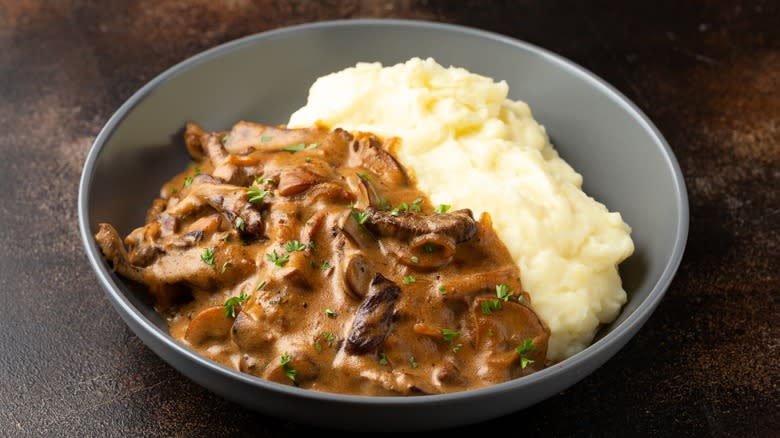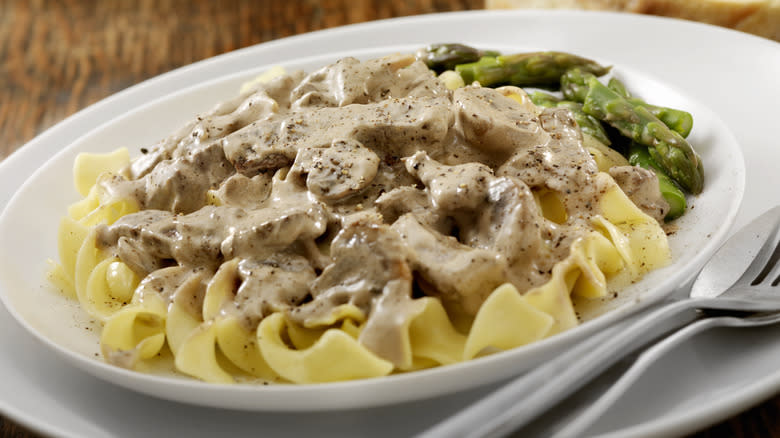What Makes Russian Beef Stroganoff Different From The American Dish?

Stewing is always an excellent way to prepare beef, especially when you're working with more affordable cuts. A bit of liquid and patience work wonders to both tenderize the meat and integrate flavor during the process. Recipes for warm beef stew come in many forms, but it's hard to deny the creamy, comforting allure of beef stroganoff.
The dish is one of Russia's most quintessential, as it has roots in pre-Soviet, Tsar-era cooking. It started as an elegant, French-inspired affair often prepared for nobility; however, the delicious and easy-to-make recipe later spread to home cooks across the Slavic nation who adapted it by using more accessible ingredients.
Into the 20th century, the dish spread to the U.S., becoming the meaty, creamy, almost fancy beef stroganoff Americans know today. In the process, this version added mushrooms and a pasta pairing, as opposed to the Russian version's potato accompaniment. Its essence and sauce prevailed, however, evincing that the dish had an easy-to-love base from the start.
Read more: Tips You Need When Cooking With Ground Beef
Russian Beef Stroganoff Pairs Tenderloin With Cream Sauce Over Potatoes

Beef stroganoff is a beloved Russian dish that takes on many variations across the country. It's dependably crafted with a sauce composed of sour cream and onions, which is typically thickened with flour. Of course, there's the namesake beef, which is sliced thin and typically sourced from the tenderloin, though it can also be sirloin, rump, or in some cases, liver. Mushrooms are a contentious addition but have appeared in Russian recipes for well over a century.
As with other foods in Russian cuisine, stroganoff is not heavily spiced. Some may add a dash of mustard, Worcestershire sauce, or tomato paste, but the palate nevertheless remains light and creamy. The dish is often served with potatoes — a distinguishing factor of the Russian version. Fried spuds are the traditional accompaniment, but mashed potatoes are also used.
The dish likely entered Russian cuisine by way of France as an interpretation of beef fricassee. Its origins are the subject of many theories, but its name and date of creation are unknown. Many interlink the dish with varying Stroganov nobility, who may have developed the preparation method after traveling around Europe. Alternatively, French-born but Russian-residing chef Charles Brière frequently receives attribution. Regardless of the dish's exact origins, it's clear that beef stroganoff was already commonly enjoyed by the late 19th century.
American Beef Stroganoff Typically Comes With Pasta

The American version of beef stroganoff came by way of Russia and emerged stateside in the early 20th century. The dish may have traveled with a wave of Russian emigrants who moved to the U.S. around this time. It was further popularized by the influential Tea Room restaurant in New York City. Because beef stroganoff was so easy to make, it became especially trendy during the 1950s and '60s, though it has since lost some of that popularity.
American beef stroganoff is similar to its Russian predecessor and employs the same sour cream base. Most versions include mushrooms, which are often regarded as a more American addition. The meat base can be swapped with affordable cuts common in the U.S., such as chuck roast or ground beef. Some chefs also reach for familiar American seasonings like garlic and may even add white wine, making this version even more distinct.
Perhaps the biggest differentiator, however, is the accompanying side. Instead of potatoes, noodles are the go-to American pairing. This lends the dish a different texture and gives it a casserole-like character reminiscent of iconic Midwestern foods, as opposed to the more European, stewed nature of the Russian version. If you want to try your hand at one of these variations, brush up on some beef stroganoff tips and stew away.
Read the original article on Tasting Table

